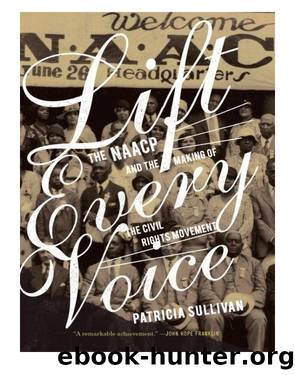Lift Every Voice by Patricia Sullivan

Author:Patricia Sullivan
Language: eng
Format: epub
Publisher: The New Press
Published: 2011-09-08T00:00:00+00:00
The buildup for war extended the reach of racial exclusion and discrimination in industrial centers across the country and magnified the War Departmentâs acceptance âlock, stock, and barrel, of the philosophies and procedures of the South.â The integration of black Americans into the national defense effort on an equal basis took on an urgency that quickly eclipsed other areas of activity and thrust jobs and wartime issues to the top of the associationâs agenda. At the same time, the changes unleashed by the war touched blacks across the nation, fueling expectations, resentments, and demands that the NAACP struggled to give voice and direction to. All of this occurred at a time when the associationâs annual income had risen to barely more than $70,000 and all felt the pressure to âdo a mammoth job on a shoestring.â31
During a monthlong tour of the West Coast in the fall of 1940, Walter White observed firsthand the widespread discrimination in the aircraft and shipyard industries and found NAACP branches energized around the fight for jobs. Reports from field organizers underscored the urgency of the issue around the country. The Committee for Participation of Negroes in the National Defense, a group of black World War I officers organized by Rayford Logan and the Pittsburgh Courier, had been pressing the federal government since 1938 for full inclusion of blacks in defense work and all branches of the armed services. The NAACPâs national office quickly moved to coordinate a targeted effort to meet this problem, instructing branches to forward information on job bias to the national office while each branch continued to organize locally to fight for access to jobs in federally funded defense plants. Protective of the NAACPâs role as the leading advocate for civil rights, White ignored the efforts of Loganâs group and lobbied allies in the Senate for a full investigation of discrimination in defense industries. He also worked with labor leader A. Philip Randolph and Arnold T. Hill of the National Urban League to secure action by the president and officials involved in war production. Plans for the Senate hearing stalled. The tepid response on the part of the administration, attuned to the interests of industrialists and southern leaders whose support was considered essential to Rooseveltâs defense program, compelled White and his allies to consider other tactics.32
In January 1941, as White and the NAACP worked to orchestrate mass protest through the branches, Randolph announced that he would lead a march on Washington to protest discrimination in the defense industry and the armed services. The founder and president of the Brotherhood of Sleeping Car Porters, Randolph was the nationâs foremost black labor leader and a major voice for civil rights. His idea offered the kind of bold strike that appealed to Whiteâs imagination, and the two joined forces in planning the most famous demonstration that never happened. Randolph envisioned bringing ten thousand people to Washington, explaining to White that âsomething dramatic has got to be done to shake official Washington and the white industrialists
Download
This site does not store any files on its server. We only index and link to content provided by other sites. Please contact the content providers to delete copyright contents if any and email us, we'll remove relevant links or contents immediately.
Never by Ken Follett(2882)
Machine Learning at Scale with H2O by Gregory Keys | David Whiting(2292)
Fairy Tale by Stephen King(2071)
Fantastic Beasts and Where to Find Them: The Original Screenplay by J. K. Rowling(2044)
Will by Will Smith(2043)
The Storyteller by Dave Grohl(1661)
Cloud Cuckoo Land by Anthony Doerr(1435)
The Becoming by Nora Roberts(1331)
Friends, Lovers, and the Big Terrible Thing by Matthew Perry(1330)
New Morning Mercies: A Daily Gospel Devotional by Paul David Tripp(1325)
A Short History of War by Jeremy Black(1300)
HBR's 10 Must Reads 2022 by Harvard Business Review(1256)
Go Tell the Bees That I Am Gone by Diana Gabaldon(1235)
Cytonic by Brandon Sanderson(1229)
Can't Hurt Me: Master Your Mind and Defy the Odds - Clean Edition by David Goggins(1227)
The Complete Witcher by Andrzej Sapkowski(1226)
515945210 by Unknown(1209)
Fear No Evil by James Patterson(1109)
This Family Does It by Kevin Sellers(1080)
